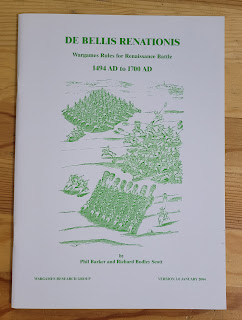De Bellis Renationis
As I have recently reviewed Field of Glory: Renaissance, it is only right and proper that I review FoG:R's forebear De Bellis Renationis (henceforth DBR)
DBR grew out of De Bellis Antiquitatis (DBA) a hugely successful set of rules for ancient and medieval game play. DBA has spawned a whole host of variants which are collectively referred to as DBx. The rules were originally written by the Wargames Research Group (WRG).
- De Bellis Renationis - the core rules
- DBR Army Lists Book 2
- De Bellis Civile 1642-1643 - scenarios for the English Civil War
- De Bellis Civile 1644-1645 - a second book of scenarios
The core rulebook is just that, a core set of rules covering the period 1494 to 1700. As you would expect from a ruleset that has been adopted by the competition circuit , they are very strict on basing, numbers of figures etc. The rules are very prescriptive, these are very definitely not toolbox rules. If it isn't in the rules then you can't do it (again, as you would expect from rules that have been picked up by the competition circuit).
The rules and supplementary volumes are A5 booklets; no pretty photographs of beautifully painted figures; what game mechanism diagrams that exist are detached from the text that they illustrate, being corralled together at the back of the book. There is a newer hardback imprint of DBR 2.0 which includes the army lists.
Just like FoG:R, DBR is a points driven game and army lists are everything. Which is where the Army Lists Book 2 comes in giving lists for the Bishops' War; the Scots, Irish Confederates, Royalist and Parliamentarians, and NMA.
 |
| 1642-1643 scenario contents |
The two scenario volumes cover 34 battles between them.
 |
| 1644 -1645 scenario contents |
The core rules were written by Phil Barker and Richard Bodley-Scott. Phil has a reputation for phrasing things in an almost legalese way, and all of the WRG rules that he helped write share this unique style. Those of you 'new' to his style of writing may be, very quickly, put off. The essence of his game lives on with DBA -RRR which is slightly easier to read and comprehend. Alternatively try and learn to play the rules from a seasoned hand, as, due to the way in which they are written you have to take real care in interpreting them.
Basing frontages are given for 25mm, 15mm, 10mm, 6mm and 2mm sized figures. Movement distances and firing ranges are given in paces, paces for the different figure sizes are defined at the front of the book so you have to work out what paces equate to in mm.
The two sides take alternative 'bounds'; rolls are made for player initiative points (PIP) which are used to move, steady or rally troops. There are lots of modifiers determining the outcome of events.
There isn't a quick reference sheet included in the rule book, however one is available here. (I must point out that I couldn't find one, that link comes courtesy of a comment below.)
I have in the past claimed to be 'old skool', enjoying consulting tables and applying modifiers to determine game events; but, I'll be very honest with you, I think DBR is tortuous to play. Familiarity with the rules is clearly the key, to me it just seems to be too much like hard work and devoid of fun. Sorry to all of you who are fans.
Equipment needed:
- ruler or tape measure (marked in mm)
- D6








.jfif)







There are playsheets available here https://blog.vexillia.me.uk/2009/04/dbr-few-resources.html
ReplyDeleteMany thanks
DeleteThey are superb rules (one of the best) but I agree learning them by yourself make it a chore. When you forget the rules and look at the flow of a battle its most close to real battle of the time and battle reports reads like actual battles and not a game.. Best way is to play multiplayer game with players controling different commands and game master/umpire well fluent in the rules.
ReplyDelete